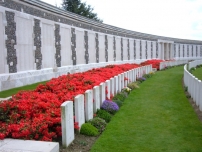| First Name: | Joseph | Last Name: | DOBSON | |
|---|---|---|---|---|
| Date of Death: | 12/10/1917 | Lived/Born In: | Earlsfield | |
| Rank: | Private | Unit: | East Kent (Buffs)7 | |
| Memorial Site: | Tyne Cot Memorial, Belgium | |||
Current Information:Born-Battersea
Third Battle of Ypres This was a campaign fought between July and November 1917 and is often referred to as the Battle of Passchendaele, a village to the north-east of Ypres which was finally captured in November. It was an attempt by the British to break out of the Ypres salient and capture the higher ground to the south and the east from which the enemy had been able to dominate the salient. It began well but two important factors weighed against them. First was the weather. The summer of 1917 turned out to be one of the the wettest on record and soon the battlefield was reduced to a morass of mud which made progress very difficult, if not impossible in places. The second was the defensive arrangements of concrete blockhouses and machine gun posts providing inter-locking fire that the Germans had constructed and which were extremely difficult and costly to counter. For 4 months this epic struggle continued by the end of which the salient had been greatly expanded in size but the vital break out had not been achieved. The First Battle of Passchendaele - 12 October, 1917 Although all the fighting during Third Ypres is often referred to as the Battle of Passchendaele, that name officially belongs to two battles fought late in the campaign. The first of these was fought on 12th October, 1917 when Australian and New Zealand troops of Second Army attacked the Passchendaele ridge, capture of which would have given them sight of the important railway junction at Roulers, a vital part of the German supply network. At the same time, units from Fifth Army attacked further north. The battle turned out to be a complete failure. The dry weather that had assisted the earlier operations in late September and early October came to an abrupt halt on 7th October when once again the skies opened and 25mm of rain fell in two days. The ground turned to mud and this affected all the preparations but most importantly, those of the artillery. Moving the guns into position was extremely difficult and once there it proved almost impossible to provide them with the stable platforms needed for accuracy and the shells that were fired often disappeared into the mud without exploding. The only gains made were small and confined to the extreme left of the attack where troops from XIV Cops reached the fringes of Houthoulst Forest. On 12th October, 55 Brigade of 18th Division attacked as part of Fifth Army at Poelcapelle, not that much remained of that village. At 5.20am, 8th East Surrey, 7th East Kent (Buffs) and 7th Royal West Kent went ‘over the top’ behind an artillery barrage that was both inadequate and mistimed. On the front of 7th Buffs, British shells or ‘friendly fire’ fell among the leading troops of ‘C’ Company while ‘D’ Company were hit by the German artillery while still waiting for the British guns to lift. As they moved forward, ‘C’ Company immediately came under fire from Gloster Farm and Point 37, but they still managed to rush one enemy post and turn the captured machine-gun around. At the same time ‘D’ Company pushed through the houses of Poelcapelle but then came under fire from Meunier House and the Brewery which checked their attack. The other two companies came up with the intention of passing through and continuing the attack but met such intense machine-gun fire that they were forced to merge with the leading lines and find what cover they could. German counter attacks were seen off and posts were established in shell holes. The swampy ground made it impossible to dig anything resembling a trench so those still on their feet sought shelter in these posts or in other shell holes. Here they remained all night and all of the next day, cold, wet and under constant artillery fire until they were relieved at dusk on 13th October. 7th Buffs suffered over 350 casualties over the two days, either killed, wounded or missing. One of these was Joseph Dobson who was killed on 12th October. |
||||
| « Back to Search Results | ||||
| If you think any of the information shown here is incorrect, Click Here to submit your amends and comments | ||||




